Encephalartos
Encephalartos is a genus of cycad native to Africa. Several species of Encephalartos are commonly referred to as bread trees,[1] bread palms[2] or kaffir bread,[3] since a bread-like starchy food can be prepared from the centre of the stem. The genus name is derived from the Greek words en (within), kephalē (head), and artos (bread), referring to the use of the pith to make food. They are, in evolutionary terms, some of the most primitive living gymnosperms.
| Encephalartos | |
|---|---|
_(20752115510).jpg.webp) | |
| a) habit of female E. hildebrandtii b) seed cone of the same, and c) seed cone of E. villosus | |
| Scientific classification | |
| Kingdom: | Plantae |
| Clade: | Tracheophytes |
| Division: | Cycadophyta |
| Class: | Cycadopsida |
| Order: | Cycadales |
| Family: | Zamiaceae |
| Subfamily: | Encephalartoideae |
| Tribe: | Encephalarteae |
| Subtribe: | Encephalartinae Benth. & Hook.f. |
| Genus: | Encephalartos Lehm. |
| Type species | |
| Encephalartos friderici-guilielmi | |
 | |
| geographical distribution of genus | |
All the species are endangered, some critically, due to their exploitation by collectors and traditional medicine gatherers.[4] The whole genus is listed under CITES Appendix I / EU Annex A. CITES prohibits international trade in specimens of these species except for certain non-commercial motives, such as scientific research.
Description
Several of the species possess stout trunks. In E. cycadifolius, the main trunks are up to 10 feet (3.0 m) high, and several of them may be united at a base where a former main trunk once grew. The persistent, pinnate leaves are arranged in a terminal spreading crown, or ascending. The rigid leaflets are variously spiny or incised along their margins. The leaflets have a number of parallel veins and no central vein.[5]
Cones
Male cones are elongated, and three or four may appear at a time. Female cones are borne singly, or up to three at a time, and may weigh up to 60 pounds (27 kg). In some species, male cones with ripe pollen emit a nauseating odour. When the pollen has been shed and the males cones decay, a strong odour of acetic acid has also been noted.[6]
Roots
Colonies of the cyanobacterium Nostoc punctiforme occur in apparent symbiosis inside the root tissue,[6] while the rootlets produce root tubercles at ground level which harbour a mycorrhizal fungus of uncertain function,[6] which is however suspected to facilitate the capturing of nitrogen from the air.[7]
Food value
Human consumption
In several species the pith of the trunk contains a copious amount of high quality starch below the crown. This was formerly cut out by native people as food. Thunberg recorded around 1772 that the Hottentots removed the stem's pith at the crown and buried it wrapped in animal skin[7] for about two months, after which they recovered it for kneading into bread,[6] whence the vernacular name "broodboom" (i.e. bread tree). The burial of the pith apparently facilitated its fermentation and softening,[6] and the dough was lightly roasted over a coal fire.[8] In 1779 Paterson likewise found that the pith of a "large palm" near King William's Town was utilised by the Africans and Hottentots as bread. The pith was removed and left till sourish, before it was kneaded into bread.[6][9]
Animal food
Their large seeds consist of an often poisonous kernel covered by an edible fleshy layer.[7] Female cones are consequently destroyed by baboons, as they relish the pith around the seeds.[6] Vervet monkeys, rodents and birds also feed on the seeds, but due to their unpredictable toxic qualities they are not recommended for human consumption.[7]
Insects
The early larval instars of some aposematic, day-flying looper moths are specific to cycads, and genus Encephalartos is one of their food plants.[10] They include the leopard magpie (most Encephalartos spp., other cycads, etc.), Millar's tiger (cultivated E. villosus), dimorphic tiger (cycads under forest canopy), spotted tigerlet (E. villosus), inflamed tigerlet (E. villosus), Staude's tigerlet (E. ngoyanus, cultivated E. villosus and Stangeria) and pallid grey (E. natalensis).[11]
In cultivation various scale insects attack the leaves of the genus. These include cycad aulacaspis scale, zamia scale and latania scale.[12]
Taxonomy
The genus was named by German botanist Johann Georg Christian Lehmann in 1834. All cycads except Cycas had been regarded as members of the genus Zamia until then, and some botanists continued to follow this line for many years after Lehmann had separated Encephalartos as a separate genus. His concept was originally much broader than the one accepted today, including also the Australian plants we now know as Macrozamia and Lepidozamia.[13]
Species
| Image | Leaves | Scientific name | Distribution |
|---|---|---|---|
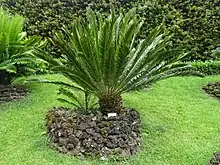 | 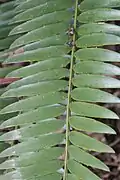 | Encephalartos aemulans | KwaZulu-Natal Province in South Africa |
 |  | Encephalartos altensteinii | Eastern Cape and south-western KwaZulu-Natal Provinces of South Africa |
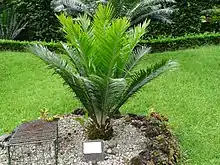 | Encephalartos aplanatus | north-eastern Swaziland, South Africa | |
 |  | Encephalartos arenarius | Eastern Cape Province, South Africa |
.jpg.webp) | .jpg.webp) | Encephalartos barteri | central Nigeria (near Tokkos, Plateau State), Nigeria (between Jebba and Ilorin), Benin (Borgou Department and near Savalou), Ghana (Volta River watershed), Togo |
| Encephalartos brevifoliolatus | Transvaal, South Africa | ||
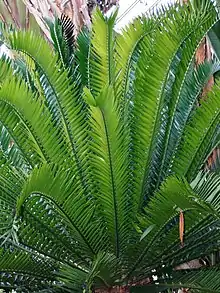 | Encephalartos bubalinus | northern Tanzania and southern Kenya | |
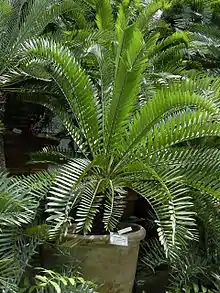 | Encephalartos caffer | Eastern Cape Province of South Africa | |
 | 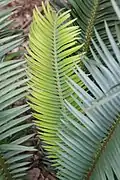 | Encephalartos cerinus | Buffelsrivier Valley of KwaZulu-Natal, South Africa. |
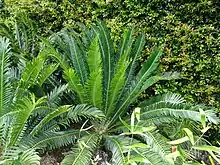 | Encephalartos chimanimaniensis | Chimanimani Mountains of eastern Zimbabwe | |
 |  | Encephalartos concinnus | Zimbabwe (Gwanda, Matabeleland South; Mberengwa, Midlands; Runde, Masvingo) |
 |  | Encephalartos cupidus | Limpopo Province, South Africa |
 | Encephalartos cycadifolius | Winterberg Mountains, Eastern Cape Province, South Africa | |
| Encephalartos delucanus | Rukwa Region of western Tanzania | ||
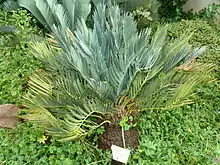 | Encephalartos dolomiticus | Wolkberg, southeastern Limpopo Province, South Africa | |
| Encephalartos dyerianus | northern Transvaal area, South Africa | ||
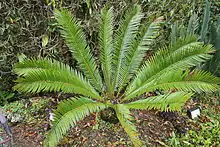 | Encephalartos equatorialis | Thurston Bay, Lake Victoria, Uganda | |
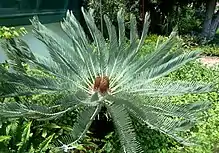 | .jpg.webp) | Encephalartos eugene-maraisii | Limpopo Province, South Africa |
.jpg.webp) | 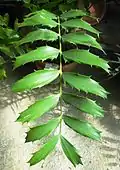 | Encephalartos ferox | south-eastern coast of Africa |
 | .jpg.webp) | Encephalartos friderici-guilielmi | Eastern Cape and KwaZulu-Natal Provinces of South Africa |
 | Encephalartos ghellinckii | KwaZulu-Natal and northern Transkei, South Africa | |
.jpg.webp) | .jpg.webp) | Encephalartos gratus | Malawi (Mulanje District) and Mozambique (Zambezia Province, Chiraba River and Navene River area, Mount Namuli, near Derre, Morrumbala, and Namarroi) |
| Encephalartos heenanii | north of Swaziland and Mpumalanga Province in South Africa | ||
 | 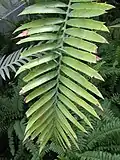 | Encephalartos hildebrandtii | Kenya and Tanzania |
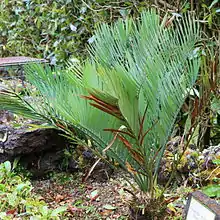 |  | Encephalartos hirsutus | Limpopo Province, South Africa |
 |  | Encephalartos horridus | Eastern Cape Province, South Africa |
| Encephalartos humilis | Mpumalanga, South Africa | ||
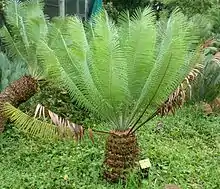 |  | Encephalartos inopinus | Limpopo Province, South Africa |
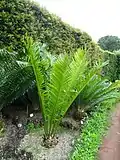 | Encephalartos ituriensis | Ituri forest area in the Democratic Republic of the Congo | |
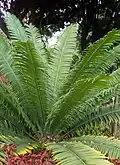 | .jpg.webp) | Encephalartos kisambo | Kenya and Tanzania |
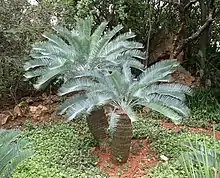 | Encephalartos laevifolius | KwaZulu-Natal, Limpopo and Mpumalanga Provinces of South Africa | |
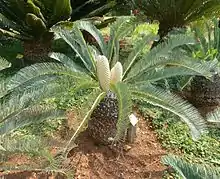 | Encephalartos lanatus | Mpumalanga Province, South Africa. | |
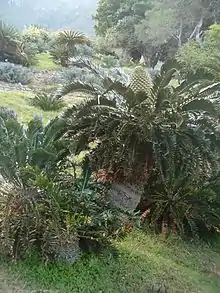 | Encephalartos latifrons | Eastern Cape Province, South Africa | |
 | .jpg.webp) | Encephalartos laurentianus | northern Angola and southern Congo (Zaire) |
 | Encephalartos lebomboensis | Lebombo Mountains of South Africa | |
 | Encephalartos lehmannii | Eastern Cape Province, South Africa | |
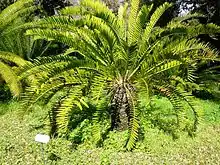 | Encephalartos longifolius | Eastern Cape Province, South Africa | |
| Encephalartos mackenziei | Didinga Hills of Namorunyang State, South Sudan | ||
| Encephalartos macrostrobilus | Moyo District, northwestern Uganda | ||
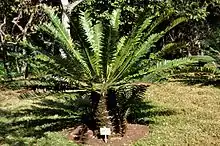 | .jpg.webp) | Encephalartos manikensis | Mozambique and Zimbabwe |
| Encephalartos marunguensis | Democratic Republic of the Congo (in the Marungu Mountains and on Muhila plateau) and Tanzania (about 100 km west of Marungu) | ||
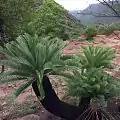 |  | Encephalartos middelburgensis | Gauteng and Mpumalanga Provinces of South Africa |
 |  | Encephalartos msinganus | KwaZulu-Natal Province, South Africa |
| Encephalartos munchii | central Mozambique | ||
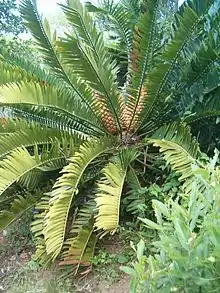 | _1.jpg.webp) | Encephalartos natalensis | Qumbu and Tabankulu areas of the northern part of the Eastern Cape, and through most of KwaZulu-Natal, South Africa |
 |  | Encephalartos ngoyanus | Ngoye Forest, in KwaZulu-Natal, South Africa |
.jpg.webp) | .jpg.webp) | Encephalartos nubimontanus | Limpopo Province, South Africa |
.jpg.webp) | .jpg.webp) | Encephalartos paucidentatus | near Barberton in Mpumalanga Province, and near Piggs Peak in northwestern Swaziland, in South Africa |
| Encephalartos poggei | DRC (Kasai Occidental, Shaba Province), Angola (Lunda Sul Province) | ||
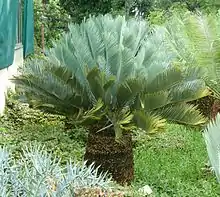 |  | Encephalartos princeps | Eastern Cape Province of South Africa |
 | .jpg.webp) | Encephalartos pterogonus | Manica Province of Mozambique |
| Encephalartos relictus | Swaziland, South Africa | ||
| Encephalartos schaijesii | near Kolwezi in Shaba Province, Democratic Republic of the Congo | ||
| Encephalartos schmitzii | Luapula River watershed, in Democratic Republic of the Congo (on the extreme south of the Kundelungu plateau, Shaba Province) and in Zambia (along the Muchinga escarpment in Luapula and Northern provinces). A subpopulation is also found in North-Western Province, Zambia, to the east of Solwezi | ||
 | Encephalartos sclavoi | Tanzania | |
 | Encephalartos senticosus | Lebombo Mountains of Mozambique, Swaziland and KwaZulu-Natal Province of South Africa. | |
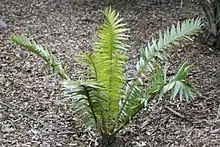 | Encephalartos septentrionalis | South Sudan, northern Uganda, northern Democratic Republic of the Congo | |
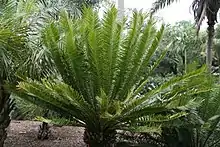 |  | Encephalartos tegulaneus | Eastern Province near Embu and on the Matthews Range in Rift Valley Province, Kenya |
 | .jpg.webp) | Encephalartos transvenosus | Limpopo Province, South Africa |
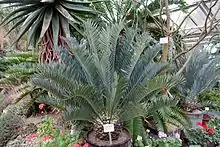 | Encephalartos trispinosus | Eastern Cape Province, South Africa | |
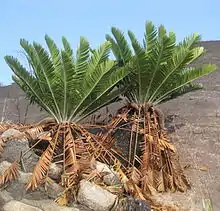 | .jpg.webp) | Encephalartos turneri | Nampula, Mazambique. |
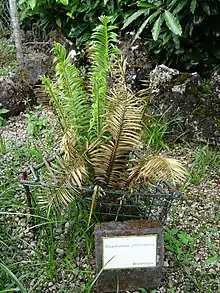 | Encephalartos umbeluziensis | Mozambique and Swaziland | |
_(45818958554).jpg.webp) |  | Encephalartos villosus | East London vicinity and Swaziland, South Africa |
 | Encephalartos whitelockii | Uganda (Kabarole District) | |
 | 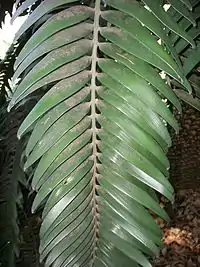 | Encephalartos woodii | KwaZulu-Natal Province, South Africa |
See also
- List of Southern African indigenous trees
References
- "Bread tree, n. phr". Dictionary of South African English. Dictionary Unit for South African English. 2019. Retrieved 27 January 2020.
- "Bread palm, n. phr". Dictionary of South African English. Dictionary Unit for South African English. 2019. Retrieved 27 January 2020.
- "Kaffir-bread, n." Dictionary of South African English. Dictionary Unit for South African English. 2019. Retrieved 27 January 2020.
- Schmidt, Ernst; Lötter, Mervyn; McCleland, Warren (2002). Trees and shrubs of Mpumalanga and Kruger National Park. Johannesburg: Jacana. p. 46. ISBN 9781919777306.
- "Encephalartos natalensis". TreeSA. Retrieved 6 July 2019.
- Smith, Christo Albertyn (1966). Common Names of South African Plants. Botanical Survey Memoir. 35. Pretoria: The Government Printer. pp. 179, 264.
- Palgrave, K.C. (1984). Trees of Southern Africa. Cape Town: Struik. p. 43. ISBN 0-86977-081-0.
- Van Bart, Martiens (16 May 1987). "Kirstenbosch kweek nou ook broodbome vir die publiek". Die Burger. Archived from the original on 29 July 2013. Retrieved 21 January 2013.
- Paterson, William (1789), A Narrative of four Journeys into the Country of the Hottentots and Caffraria, in 1777-79
- Donaldson, J. S.; Basenberg, J. D. (1995). "Life history and host range of the leopard magpie moth, Zerenopsis leopardina Felder (Lepidoptera: Geometridae)". African Entomology. 3 (2): 103–110. Retrieved 22 September 2015.
- Cooper, Michael Robert; Goode, Douglas (2004). The cycads and cycad moths of Kwazulu-Natal. New Germany [South Africa]: Peroniceras Press. pp. 76–93. ISBN 062031978X.
- Miller, Douglass R.; Davidson, John A. (2005). Armored scale insect pests of trees and shrubs: (Hemiptera: Diaspididae). Ithaca (N.Y.): Cornell university press. p. 425. ISBN 0801442796.
- Alice Notten (May 2002). "Encephalartos woodii Sander". Kirstenbosch National Botanical Garden and South African National Biodiversity Institute. Retrieved 2006-11-16.
External links
| Wikimedia Commons has media related to Encephalartos. |
| Wikispecies has information related to Encephalartos. |
| Wikisource has the text of the 1911 Encyclopædia Britannica article Kaffir Bread. |